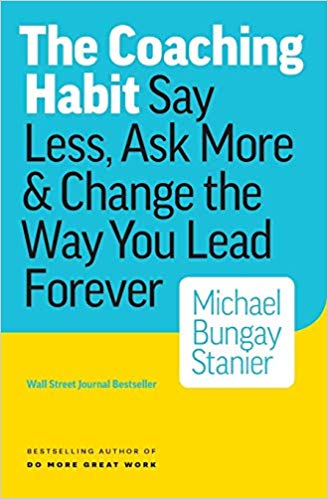
The Socratic Method for the Modern Leader
I love answering people’s questions.
It fills my ego with an almost perverse sort of glee when somebody comes to me with a question I definitively know the answer to. The joy my ego derives is directly linked to the unspoken power I now wield over the other person.
Now, you might disagree, thinking the word power in this context is stretching things a little thin, but if knowledge is power, and somebody is coming to me to acquire said knowledge, then it must follow that I do in fact have all the power.
This isn’t necessarily a bad thing.
But if you’re in any sort of leadership role, it’s quite likely this simple power disparity is killing your teams ability to function at an exceptional level.
Why?
Because teams who’ve been trained to go to their manager for answers have inadvertently been trained to stop looking for answers themselves.
On the micro-day-to-day level this isn’t such a big deal. There will always be situations where people come seeking an answer, and in the interest of time and efficiency, it’s best just to give them what they need.
On the macro-scale, however, this tendency to always provide answers at the drop of a hat is handicapping your team’s ability to think critically through the cascade of possibilites to arrive at the most suitable course of action.
Being an effective leader is never about being the smartest person in the room, or being the one who always knows the right way, or even the one whose always making the decisions…
No, effective leaders know their primary obligation is to helping grow and develop the skills of the people around them so that they can realize their full potential.
Effective leaders trust in the synergistic powers of the team.
All this is to say, if you want to be an effective leader, you’ve got to learn how to grow the people around you.
The first step towards that end, is teaching them how to find answers for themselves.
To do that, we’re going to channel a little of our old friend, Socrates.
The Socratic Method
If you’re not familiar with the Socratic Method, it’s rather easy:
You ask a bunch of questions.
The Socratic Method is a cooperative form of rhetoric based on the asking and answering of questions.
Questions are the best type of teacher because they stimulate critical thinking.
By applying critical thinking to a series of hypothesis (or put less scientifically: a series of potential actions), we confidently winnow down options through the process of elimination.
If you’re able to guide the person coming to you for answers through the maze of potentially self-eliminating contradictions inherent in most plans, then what you’re left with is irrefutably the best course of action.
Okay, I used a lot of big words to overly complicate a rather simple premise.
Let me try again.
Use questions to weed out the good options from the bad.
It’s really that simple.
Now, for those who like action steps, here’s 4 steps you can follow to guide you through the process.
But wait…
Before I give you these action steps, a quick master tip on asking questions:
Question Asking Master Tips
Ask “what” and “how” based questions instead of “why”.
It happens on a subconscious level, but your brain reacts very differently towhat and how based questions than it does to why.
When you hear, “Why did you do such and such?”, your brain interprets that as a threat.
It’s an accusation.
On the whole, our brains leave critical thinking mode when we feel attacked.
Better in this instance would be: “What were the other options you considered?”
With what based questions your personal judgment is not on the line. Freed from that stress, you’re more easily able to hop into critical thinking mode and actually consider the sequence of events that lead to your current predicament.
If you want to get the most out of your questions, phrase them in terms of what, or how, never why.
Okay, now that we got that out of the way, let’s chat about the 4 action steps for employing the Socratic Method at work.
Get to the Root
“What’s the real difficulty here for you?”

I stole this question from Michael Bungay Stanier’s The Coaching Habit: Say Less, Ask More, and Change the Way You Lead Forever and I absolutely love it because you’re making the other person do all the heavy lifting. They’re mining their gray matter to find and articulate exactly what’s standing between them and their desired outcome.
This is not only beneficial for them, but also for you as the person who most definitely doesn’t want to be the guy or gal wasting time helping to solve the wrong problem.
Solving the wrong problem is like mopping up a puddle on the bathroom floor when there’s still a burst pipe overhead.
Treat the disease, never the symptom.
Asking “What’s the real difficulty here for you?” brings you one step closer to making the right diagnosis.
Find Options
“What are the options?”
Depending on the problem, the other person might not even have a clue what the options are. In these instances, the Socratic Method won’t get you far.
Do the other person a favor and throw them a bone.
Give some options.
This isn’t the same as giving them the answer.
You might know without a shadow of a doubt that Options A, B, and D are downright foolhardy. You could save time and energy by just telling them, “Go with Option C”, but you’ve denied the other person a learning opportunity.
That’s not to say you set them up for failure and let them embark on a wild-goose chase. At this point in the conversation it’s all about the mental exercise of exploring and evaluating options, and weeighing the pros and cons to arrive at a best-guess course of action.
You, perched atop your mountain of wisdom, can guide them to the correct path, but you must never throw a leash around their neck and drag them to the answer. This is where the 3rd step comes in.
Educate About Options
“In the past, I’ve experienced this…”
When educating about the options before a person, it’s helpful to coach things in terms of what has and hasn’t worked for you in the past.
If you want to get the most out of this exercise, then after sharing your experience on a topic, you should follow up by asking the person why they think you were met with your particular outcome.
For instance: “I tried such and such once before and had mixed results because of…What do you suppose lead to that outcome?”
This sort of share-and-question approach has the benefit of gifting chunks of relevant knowledge that the other person can then critically evaluate.
Critical evaluation is of the utmost importance here.
There’s a famous saying:
To Learn, Recall.
In this instance, you’re encouraging the other person to learn by reminiscing on a sequence of events they weren’t actually a part of. They’re using their imagination to project and predict the most likely outcome.
It’s hard to overstate just how valuable this ability is. If everybody on your team was capable of this sort of high level situational analysis, you would have one effective team indeed.
And at the end of the day, isn’t that the goal?
Give a Recommendation, But Let Them Choose
“From how you’ve described the problem, I would probably try… but you’re free to pursue the option that makes the most sense to you.”
Time for the rubber to meet the road.
Effective leadership boils down to trust.
The trust you have in the abilities and judgment of your team. And the trust your team has in your continued support.
There’s no way around it. If you want your team to grow to the fullest of their abilities, you’re going to have to let them jump out of the nest at some point
If you’ve equipped them with the tools necessary to critically evaluate a situation and arrive at a reasonable solution, then you must allow them the opportunity to succeed…
Or fail.
There are only two types of errors: Judgment and Execution
One of these is forgivable. The other is not.
A judgment error occurs when you’ve sifted through the potential courses of action and arrived at the wrong one.
An execution error occurs when you fail to follow-through on your intended course of action.
Judgment errors are painful, but they are to be expected during the learning process. The important part here is: Was the system of evaluation used to arrive at the faulty judgment sound?
If yes, well, what can ya do? Sometimes you just plain old get it wrong.
Execution errors, on the other hand, stem from poor follow-through. In 99.9% of situations, execution errors are entirely avoidable.
To be an effective leader, you have to trust your team’s ability to exercise the type of critical thinking that leads to favorable outcomes and support them, even when they get it wrong.
Without supporting their attempts, they will soon stop trying for fear of failure. And that’s a bad place for any team to be.
So support your team and give them the freedom to make Judgment Errors, while working hard with them to eliminate Execution Erros.
At the end of the day, this is the path to growing a highly effective team. So stop feeding your ego. Stop being so quick to dole out the answer.
Next time somebody comes to you for help, sit back and channel your inner Socrates.